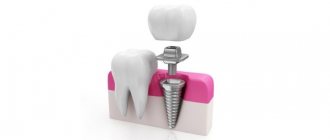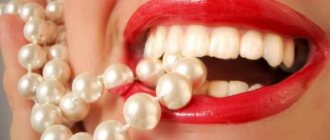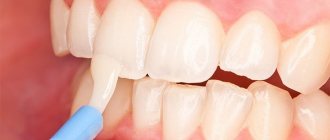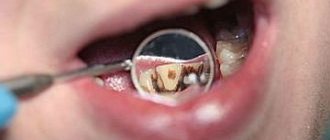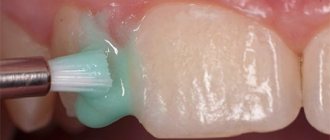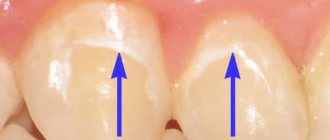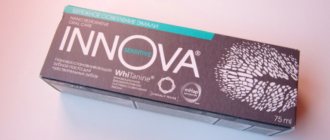The most common causes of pathology
Doctors call hyperesthesia the increased sensitivity of the hard tissues of the tooth. This is the official name for this problem. Pathology signals that your enamel is demineralized, thinned, damaged or weakened, so any slightest impact on it can cause pronounced discomfort.
If tooth sensitivity is increased, then, of course, there are certain reasons for this. Let's list them:
- incorrect and too aggressive technique for daily oral hygiene: for example, strong pressure on the brush,
- accumulation of a large amount of soft and hard bacterial plaque,
- dental problems and diseases: malocclusion, caries, increased enamel abrasion, non-carious lesions (fluorosis, hypoplasia, wedge-shaped defect, erosion), severe periodontitis, when gum recession occurs and the necks of the teeth are exposed,
- the use of brushes with hard bristles and highly abrasive pastes that are unsuitable for the condition of the oral cavity,
- abuse of whitening procedures,
- long-term use of medications and antibiotics,
- poor diet
- bad habits: smoking, opening bottles, cracking nuts, chewing threads,
- love of salty, spicy and especially sour foods: these foods make the enamel porous and can corrode it,
- avitaminosis,
- hormonal disorders,
- hard tissue injuries and bruxism,
- loose or old fillings.
Important! Hyperesthesia may appear due to the loss of hard tissue as a result of the development of caries, increased abrasion, and preparation for orthopedic structures. But in some cases, the problem is not caused by the loss of enamel, cement or dentin, but occurs against the background of periodontal tissue diseases and internal pathologies of the body.
What to do if your teeth become sensitive
There are several professional methods of dental treatment aimed at reducing sensitivity, which has increased due to open dentinal tubules. Eg:
- the exposed tooth surface is sealed with a special composite material;
- exposed areas of dentin are sealed with fluoride varnish, which creates effective protection against external irritants;
- The dental tray is filled with fluoride gel and kept in the mouth for about 5–10 minutes, after which it must be removed.
If teeth have become sensitive due to chips or cracks, their integrity must be restored using a light-curing composite or remineralizing gels.
Dental restoration using composite
Operation
Surgical intervention may be required only if the cause of increased tooth sensitivity is periodontal disease, which has led to exposure of the dentin canals. Surgical actions will be aimed at changing the level of the gums.
Treatment of bite defects
Bite defects can be cured at any age, but it is better not to delay them, since due to incorrect jaw closure, the teeth gradually become deformed and crumble. You can change your bite and reduce tooth sensitivity using special dental structures: plates, braces.
Remineralizing therapy
Remineralization is the saturation of hard dental tissues with minerals. Before the procedure, the tooth surface must be cleaned of food debris, plaque and tartar.
Algorithm for carrying out a remineralizing treatment procedure in a dental clinic:
- professional teeth cleaning;
- cleaning the enamel from saliva and further insulating the teeth;
- drying the surface to be treated;
- applying a solution of calcium gluconate (from 10%) or Remodent to the tooth surface using a regular cotton swab;
- treatment of enamel with sodium fluoride solution.
The essence of dental remineralization
If you have very sensitive teeth that hurt severely and constantly, in addition to local remineralizing therapy, taking calcium gluconate tablets (three times a day) is indicated. Sometimes home use of a fluoride gel tray is prescribed.
Re-filling
Sometimes tooth sensitivity occurs after improper treatment of caries. For example, when a dentist installs a low-quality filling that does not fit tightly to the tooth or has sharp edges. Because of this, a gap is formed between the pulp and the filling, into which product residues penetrate, which leads to the development of inflammation. In this case, the old filling is removed and a new one is installed in its place.
Physiotherapy
Treatment of increased sensitivity of teeth, which arose after their lightening, involves the use of physiotherapeutic procedures:
- Electrophoresis with calcium gluconate, B vitamins, anesthetics, silver, calcium, fluorine and phosphorus.
- Diadynamic therapy – treatment with electric currents.
- Application of sinusoidal currents.
- Ultraviolet radiation, which helps get rid of severe tooth sensitivity.
Causes of sensitivity after filling and prosthetics
If tooth sensitivity appears after filling or prosthetics, then this situation can be considered normal. But only on the condition that the unpleasant symptom decreases with each subsequent day and disappears completely after 7–10 days.
Read the article on the topic - “Tooth hurts under the crown.”
High sensitivity can also appear in a recently pulpless tooth. Discomfort arises as a natural physiological reaction of the body and tissues of the oral cavity to medical manipulations, preparation, and the use of various medications. However, if an unpleasant symptom continues to bother you for a long time, this may indicate that medical errors were made during treatment.
“After treatment of deep caries, about a couple of months later, pain began. At first I didn’t attach any importance to this, because the filling was intact. But the pain became more and more intense, I already wanted to rip off this filling to get rid of the pain. I had to go to the doctor, and it turned out that it was no longer caries, but pulpitis, and initially it was necessary to remove the nerve. But the doctor then did not put a temporary filling or check, he immediately put a permanent one and sent me home. I was lucky that they did it for free, but the negativity remained, I won’t go to that clinic again!”
Dina_1982, review from otzovik.com
Prevention
To prevent tooth sensitivity, it is enough to follow the following rules:
- It is better to refuse toothpicks and brushes with hard bristles. Sonic or regular brushes with soft bristles are suitable for cleaning the surface of teeth, and irrigators that do not irritate the gums or damage the enamel are used to remove food debris.
- Remove tartar in a timely manner. However, it is not recommended to whiten your teeth yourself. This is only done in the dental office.
- Do not overuse solid foods; include vitamins and minerals in your daily diet.
- See your dentist regularly. A preventive examination should be performed annually. If there is a predisposition to hyperesthesia - twice a year.
- Use desensitizing pastes that can strengthen your enamel.
- Use a fluoride mouthwash. To achieve the effect, the duration of the procedure should be 2-3 minutes. A course of remineralization will help to avoid unpleasant sensations from drugs with a high content of potassium salts and fluorides.
Increased tooth sensitivity is not a death sentence. With proper and timely treatment, this problem can be eliminated. The main thing is not to let the situation get worse.
Author of the article
Sensitivity after bleaching - why it occurs and what to do
The appearance of hyperesthesia after bleaching is a fairly common problem that many patients complain about. However, painful sensations can occur after whitening, both professional and at home.
“If the procedure is carried out in dentistry, then the risk of developing hyperesthesia is minimal, because the doctor selects the optimal whitening method for the patient, based on the clinical situation. In addition, before the procedure, the dentist eliminates all problems in the oral cavity and strengthens the enamel. But those people who whiten at home are at much greater risk. They use highly abrasive products that, if used carelessly, injure and destroy enamel. When carrying out home whitening, many do not even think about the need to cure their teeth first,” says V.N. Kashaeva, dental hygienist.
Doctors admit that even during professional whitening, the enamel becomes more porous, and sensitive dentinal tubules open up from exposure to lamps and active components of bleaching compounds. That's why discomfort occurs. To relieve pain and other unpleasant symptoms, after the procedure you need to use products that help strengthen the enamel and close the dentinal tubules. These are various fluoridating and remineralizing pastes.
If you want the procedure to be as safe as possible for the enamel, and after it there are no complications such as increased sensitivity, then follow the following recommendations:
- Get whitening done at the dentist's office. Or use professional products for home use - gels (ZOOM, Amazing White), pencils, strips. Remember that highly abrasive folk remedies (activated carbon, soda and salt) and pastes cause much more damage to enamel than professional ones,
- before the procedure, cure all dental diseases and make sure that there are no problems in the oral cavity,
- Start strengthening your enamel 2 weeks before whitening and continue doing this for 2 weeks after the procedure.
What diseases can be confused with increased sensitivity of teeth?
Hyperesthesia is often confused with the acute form of pulpitis, since in both situations there are pain sensations, the exact location of which is difficult to determine.
Therefore, in addition to an objective examination, doctors resort to electroodontic diagnostics. With pulpitis, the electrical excitability of the pulp is always beyond 20 μA, and with hyperesthesia - no higher than 8 μA.
You should pay attention to the duration of pain: with pulpitis, pain occurs spontaneously, at night, and is long-lasting. With hyperesthesia, pain occurs only under the influence of irritants and disappears immediately after their elimination.
How to understand that hyperesthesia has appeared
Let's talk about the signs of tooth sensitivity. They are easy to recognize. The main symptom of hyperesthesia is short-term pain, which quickly passes after the irritating factor is eliminated.
Anything can become an irritant. Tooth sensitivity can occur when exposed to cold temperatures, such as inhaling icy air and eating ice cream. Pain can also occur as a reaction to a hot dish or drink. Hard tissues react to sour, salty, sweet and spicy foods. The enamel may ache during daily hygiene procedures, for example, from the touch of a brush.
Painful sensations can affect only a certain area, or they can spread throughout the entire row, that is, be generalized. Some researchers have also found that the problem is mainly characteristic of the frontal teeth rather than the chewing teeth1.
On a note! Cervical tooth sensitivity often occurs due to a wedge-shaped defect or cervical caries. If soreness of hard tissues appears near the gums and at the same time spreads generally, throughout the entire row, then this may indicate the progression of such a serious disease as periodontitis, because against its background the necks and roots of the teeth are exposed.
Classification of hyperesthesia
Sensitivity of teeth to external irritants: cold and hot, sour, sweet and salty - can be classified based on the causes preceding the onset of the disease, as well as the location and characteristics of its course.
According to the clinical course
There are three degrees of hyperesthesia:
- 1 – response of teeth to thermal stimuli;
- 2 – enamel sensitivity to chemicals;
- 3 – pain appears even when you touch the tooth and intensifies at night.
By distribution
Hyperesthesia can affect one tooth or several. Most often, those dental units that are located nearby become sensitive. Local pathology is accompanied by acute pain in the area of one tooth. Most often it occurs due to:
- caries and enamel defects;
- improper treatment and filling of canals;
- ultrasonic or mechanical cleaning of teeth from tartar and plaque;
- installation of prostheses near the problem area;
- tooth preparation before installing the inlay.
Hyperesthesia of the entire jaw is usually associated with exposure of the tooth necks and dentin against the background of periodontal diseases - periodontal disease, periodontitis.
Severe sensitivity of all teeth can develop with:
- periodontal disease;
- traumatic change in enamel;
- enamel erosion;
- multiple caries;
- hereditary predisposition.
By origin
Hyperesthesia can be caused by thinning of enamel, dentin, cement or all hard tissues of the tooth. In the latter case, the disease manifests itself in the presence of carious cavities, multiple dental defects and erosions. In the first three, there may not be pathogenic formations in the oral cavity, since the key cause of increased dental sensitivity is functional systemic disorders in the body.
Types of professional dental care
Have you noticed that you have increased tooth sensitivity? What to do in this situation? You need to see a dentist. The doctor will conduct a detailed diagnosis and help you get rid of the problem.
Based on the clinical situation and the cause of hyperesthesia, the dentist can prescribe different procedures that will help cure the pathology. Let's list them:
- professional oral hygiene,
- fluoridation and remotherapy: procedures strengthen, saturate hard tissues with useful elements, increase resistance to negative factors and help reduce sensitivity. It is recommended to carry out 1-2 times a year as a preventive measure, even if you do not have dental problems,
- electrophoresis: thanks to this procedure, it is possible to improve the susceptibility of hard tissues to the beneficial substances of fluorinated and remineralizing compounds,
- caries treatment and filling,
- installation of veneers and lumineers,
- prosthetics with crowns,
- anti-inflammatory therapy for gums: this is mandatory if hyperesthesia has developed against the background of gingivitis, periodontitis or periodontal disease,
- mucosal plastic surgery: for example, with gum recession and root exposure,
- wearing braces, mouthguards and other orthodontic devices to correct bite pathologies: an orthodontist will tell you how to treat bite abnormalities.
To completely remove sensitivity, the doctor, in addition to the main course of treatment, may recommend enamel-strengthening products for home use, such as Tooth Mousse gel.
Drugs to reduce tooth sensitivity
"Ftorlak"
In addition to the use of medicated pastes and rinses at home, other means to reduce tooth sensitivity have long been successfully used. One of the most popular “home” procedures is coating teeth with Fluoride Lacquer, what is it, what is the essence of the procedure?
“Fluorovarnish” is a viscous substance with the aroma of pine needles, which is applied to the surface of the teeth. As a result of the interaction of fluoride contained in the preparation and the surface layer of enamel, a kind of protective film is formed on the teeth.
Fluoride, penetrating inside the enamel, prevents microorganisms “living” in plaque on the teeth from absorbing glucose and, accordingly, producing acid that destroys the enamel.
In addition, fluoride helps restore the mineral structure of the enamel and improve the health of the gums, which means it eliminates several causes of hyperesthesia at once. And most importantly, it effectively relieves the painful sensitivity of hard dental tissues.
The procedure for coating teeth with Fluoride Lacquer can be performed on both adults and children. The price of “Ftorlak” is quite affordable, and the complexity of this procedure is no more difficult than applying nail polish. Repeat it 3 times with an interval of 2-4 days, while the varnish does not affect the taste of food in any way.
According to experts, the invisible film will last you six months. I tried this procedure on myself, in principle I liked everything, except for the discrepancies with the assurances of specialists about the duration of action.
My fluoride varnish did not last more than two weeks, perhaps because I applied it in the summer; the menu included a lot of vegetables and fruits, due to the acid of which the “varnish” dissolved very quickly, so I did not repeat the procedure.
In terms of price, three procedures cost about $10, I won’t say that the price is high, but not for just two weeks of protection.
"Fluocal gel"
Successful treatment of tooth sensitivity at home is also possible with the help of Fluocal Gel.
Reviews from both dentists and consumers indicate its effectiveness and ease of use. The active ingredients, as in the case of Fluoride Varnish, are active fluorine compounds.
They also strengthen tooth enamel by forming a protective mineral layer on the surface of the teeth, which prevents the enamel from being exposed to external irritants and reduces the risk of the occurrence (or development) of caries.
The technology for applying “Fluocal-gel” is also similar: after thoroughly brushing your teeth, apply the drug with a cotton swab (for 4 minutes), then you need to spit out the remaining gel, and refrain from eating and drinking for 0.5 hours. It is enough to carry out this procedure 1-2 times a year.
Unfortunately, I haven’t tried this procedure myself; it’s not so easy to buy a quality product from us, but by this time, fortunately, a virtuoso dentist was found who was able to fill the necks of the teeth that were causing inconvenience.
Remodent, a powder for teeth, also knows how to treat tooth sensitivity at home. It can be used both for applications, soaking cotton swabs with it (course - 10 procedures lasting 15-20 minutes), and for rinsing (in the form of a 3% solution).
This new generation drug contains many microelements: calcium, potassium, zinc, magnesium, sodium, manganese, iron, copper, etc. “Remodent”, according to reviews, copes well with superficial sensitivity in the area of the necks of teeth, with enamel erosion, as well as with pathological abrasion.
Along the way, it treats caries and enamel necrosis in the initial stage, reduces bleeding gums and relieves inflammation in periodontal diseases.
Treatment at home
Many people are interested in how to relieve tooth sensitivity at home. In agreement with the dentist, you can use specialized products for these purposes - “Ftorlak”, “Fluokal”, “Profokar”, “Diplen Denta F” films. Why is it necessary to consult a dentist? These drugs are commercially available in pharmacies, but they contain fluoride, which can be harmful to some people (children and patients with fluorosis) and only worsen the clinical situation.
It is possible to strengthen hard tissues and reduce tooth sensitivity with the help of remineralizing pastes that can be used at home - REMBRANDT Sensitive, ROCS Medical Mineral, Sensodyne F, PresiDENT Sensitive plus, Lacalut Sensitive. Such products have a rich composition and a minimal level of abrasiveness.
Important! Hypersensitivity is not a disease, but it is a symptom that indicates dental problems. Therefore, the first step towards reducing it is to see a doctor.
It will be good if you begin to strengthen the tissues not only from the outside, but also from the inside. To do this, you can take courses of vitamin-mineral complexes with a high calcium content (“Calcium-D3 Nycomed”, “Kalcemin”). It is necessary to include in your daily diet foods rich in vitamins D and C, as well as phosphorus, calcium and magnesium.
If tooth sensitivity has worsened, then you can relieve the symptom at home, eliminating possible irritating factors: hard, sour and spicy foods, hot and cold. Consult your doctor; you may temporarily need to use a soft-bristled brush and stop using irrigator and floss.
At home, it is important to strengthen not only hard tissues, but also gums, since the condition and general presence of teeth may depend on their health. What remedy is suitable for this? A good prevention and additional measure to the main treatment would be the use of decoctions of chamomile and oak bark, drops of tea tree oil, and a solution of water with soda and salt. The listed natural remedies can be used to rinse your mouth after eating and hygienic cleaning, which will allow you to more effectively remove plaque and have an antiseptic and anti-inflammatory effect.
Treatment of tooth sensitivity with folk remedies
Is traditional medicine effective in the treatment of tooth sensitivity, how to relieve hyperesthesia with folk remedies?
There are many different remedies in the collection of folk recipes for sensitive enamel. Here are some of them:
- Tea tree oil (3 drops per 1 cup warm water). Rinse 3-4 times a day. You can add the same amount of eucalyptus essential oil to the tea tree.
- Oak bark (1 tbsp per 1 tbsp boiled water). Leave for 5-10 minutes or keep on fire for the same time.
- Chamomile and burdock (or lemon balm). 1 tsp. herbs pour 1 tbsp. boiling water Leave to rinse for 1 hour.
- An “emergency remedy” is warm boiled milk (preferably homemade). Hold in mouth to reduce painful sensitivity for 10-15 seconds.
Such products will definitely come in handy if you don’t have toothpaste or other preparations for sensitive enamel on hand.
Treatment
Treatment of dental hyperesthesia should begin with a thorough examination of the oral cavity by a dentist. The patient explains in detail how and when tooth sensitivity increased, and the doctor confirms the diagnosis and assesses the severity of the condition. If the problem is caused by a tooth injury, then therapeutic treatment will eliminate tooth sensitivity and quickly restore all lost functions. The same applies to carious lesions, after treatment of which it is also recommended to carry out professional cleaning of the oral cavity.
Professional cleaning of the oral cavity is carried out by a dentist in the clinic.
After caries has been eliminated, hyperesthesia may persist on living teeth. The fact is that during treatment, about 40% of the enamel is etched with phosphoric acid (so that the filling is better fixed). Acid thins the enamel and washes away calcium from it. The dentist specially treats the surface of the entire tooth with a protective agent after the filling is placed. But this does not guarantee that pain will be completely absent: irritants can still penetrate through the thin enamel to the nerve. If the culprit is disorders of various body systems or mental problems of the patient, then eliminating the root cause will also be a treatment for dental hyperesthesia. Night grinding requires long-term psychological therapy. Malocclusion is also complicated by many factors, and it will have to be treated with the help of special structures or surgery. In both cases, it is necessary to simultaneously restore the enamel structure.
Causes
Hyperesthesia has recently become a fairly common phenomenon. This nuisance mainly affects women, and is less common in men. Up to 30 years of age, the enamel is still strong; over time, it becomes depleted and microcracks appear, which leads to increased sensitivity. With age, the sensitivity of dentin decreases, and the problem disappears on its own.
The reasons for the development of hyperesthesia can be processes not related to caries:
- Malocclusion, which places a lot of stress on the teeth. As a result, dentin is depleted, and high susceptibility to external irritants appears;
- Bad habits. The development of the problem is caused by teeth grinding (bruxism), the habit of gnawing hard objects;
- Poor-quality enamel whitening is often affected; carrying out the procedure at home is especially dangerous;
- Hard toothbrush, improper oral hygiene, damage to enamel during dental treatment;
- Psychoneuroses, nervous conditions, disorders of internal organs and metabolism, problems with the gastrointestinal tract.
Caries cannot itself cause the appearance of hyperesthesia, but it contributes to its development. When treating caries, the tooth often becomes hypersensitive to external influences. This is also caused by periodontal diseases, in which dystrophic and inflammatory processes affect the gums. The neck of the tooth is exposed, and unprotected areas become sensitive.
What causes hyperesthesia, besides the above factors? An increase in tooth sensitivity is facilitated by various injuries and the installation of crowns, in which the top layer of enamel is ground down. In some cases, the problem can be caused by a lack of calcium; the enamel becomes porous.
This condition intensifies when exposed to several stimuli at once. Unpleasant sensations occur periodically, most often after a lull or remission, an exacerbation occurs, while the usual food causes pain.
Hyperesthesia can be classified according to various criteria. One tooth or several may become sensitive. Often the problem affects the entire dentition or oral cavity. It can be difficult to detect the problem area, since the pain radiates to neighboring teeth, and it is not clear which element is affected.
Caries - causes, prevention. How to brush your teeth correctly? Detailed instructions with Video! Teeth whitening at home is the most effective means.
According to the course, three stages of excitability can be distinguished; at the first stage, the tooth reacts to changes in temperature, at the second stage the reaction also occurs to chemical stimuli. The third stage – all stimuli have an influence.
Why do our teeth become so sensitive?
Hyperesthesia is what doctors call this phenomenon. And above all, it is a concomitant symptom of any other oral diseases. This can be periodontitis, caries, as well as a consequence of erosion or damage and cracks in the enamel.
It is worth noting that smokers and people who have certain diseases of the nervous system often suffer from hyperesthesia. Also, the cause of this disease can be poor nutrition, lack of vitamins, stress, various diets, and even improper brushing, when a person presses too hard on the brush or improper brushing technique.
In such cases, folk remedies for tooth sensitivity will help very well; if you use them regularly, you will solve your problem.
Dental hypersensitivity is not exactly a pathology; rather, it is a feature of the structure of tooth enamel, which helps to increase the contact surface of nerve endings with food of different temperatures.
To help such patients, dentists prescribe various toothpastes and creams, but traditional medicine also does not stand aside. If increased tooth sensitivity is caused by an inflammatory process, rinse your mouth with infusions of oak bark, calendula, and chamomile. Be careful with these solutions - they dry out the mucous membrane.
Tea tree oil and propolis will also relieve discomfort and improve your quality of life. These substances also perfectly eliminate bad breath.
Traditional medicine for hyperesthesia
In the arsenal of herbalists you can find a wide range of different remedies that can not only help reduce sensitivity, but also strengthen the gums and enamel and stop loosening and destruction. So, what do traditional healers advise?
Herbal decoctions and infusions
There is one recipe for preparing a decoction for all herbs: 1 tablespoon of dry crushed herbs, pour boiling water over it and bring to a boil over low heat. Then remove from heat, let it brew for about an hour, strain and rinse your mouth with a small amount of the broth. Best after a meal.
- Oak bark decoction. Has astringent and antiseptic properties. Strengthens tooth enamel, reduces sensitivity, relieves inflammation of the gums.
- Chamomile. Combines anti-inflammatory, soothing and antibacterial properties. It not only reduces sensitivity, but also takes care of the oral cavity as a whole.
- Burdock. Fights sensitivity, relieves inflammation.
- Sage. It has anti-inflammatory, astringent and antiseptic properties. Reduces sensitivity, eliminates inflammation and strengthens teeth.
- Snake mountaineer. It copes not only with hyperesthesia, but also strengthens the gums and eliminates bad breath.
- Oregano. Has anti-inflammatory and analgesic properties.
- Calendula. Has a pronounced anti-inflammatory effect.
You can mix all these herbs in equal proportions and make a decoction based on this “collection”.
Unusual effective recipes
1. Tea tree oil. Dilute 3 drops of this oil in a glass of water and rinse your mouth with the resulting solution 4 times a day. Tea tree oil will not only reduce sensitivity, but also neutralize bad breath and strengthen tooth enamel.
2. Eggplant peel. An infusion of dried peel is used to rinse the mouth. It is believed that such rinses will help strengthen the enamel and gums.
3. Propolis. It is either chewed or an alcohol tincture is made with it.
4. To reduce the sensitivity of the enamel, you can drink warm milk, holding it in your mouth for a short time. This method has been used in villages for a long time.
5. Rinsing the mouth with a salt solution.
6. Rinse your mouth with a solution of baking soda and tea tree oil. This method not only helps reduce sensitivity, but also fights plaque.
7. Juices of vegetables and plants. Horsetail juice with honey, cucumber juice and turnip juice can help reduce enamel sensitivity.
8. Sprouted wheat grains. Eating them daily in the form of jelly and porridge based on them.
9. Red hot pepper. It should be consumed in small quantities, as it can cause burns to the mucous tissues of the mouth and stomach. Has an analgesic and distracting effect.
It should be noted that people suffering from hyperesthesia should not neglect proper nutrition and should reduce the amount of sugar in their diet, or even better, give it up completely.
It is recommended to eat: sea fish, cottage cheese and cheese, eggs, milk, liver and wild berries such as cloudberries, blackberries, lingonberries. All these products have a beneficial effect on dental tissue.
Additional intake of phosphorus and vitamins C and D is also advisable. Avoid drinking too hot and too cold, breathing with your mouth open in the cold, and smoking.
Hypersensitivity of tooth enamel can bother a person from time to time, or it can become his constant companion in life. Therefore, it should be remembered that self-medication at home is still not always good, because the cause of hyperesthesia can also be various hidden inflammatory processes that only a doctor can identify.
And only a doctor in this case can prescribe competent treatment and help prevent further dental disease and tooth loss.
Reason #2: Bruxism
For those with this disease, it is extremely important to begin treatment as soon as possible. Grinding of teeth at night has never brought anyone any good, as it often indicates problems with the nervous system and has deeply psychological causes. The presence of bruxism requires visiting not only a dentist, but also a neurologist or psychologist. The first will help restore defects and prescribe special mouthguards that will protect the enamel from rapid abrasion and sensitivity, the second will prescribe a set of sedatives and will get to the root of the problem.
Bruxism causes teeth to wear down and become sensitive.
Erosion, malocclusion, the presence of a wedge-shaped defect, increased or pathological abrasion of enamel can also be causes of increased tooth sensitivity. It can also be caused by general diseases of the body associated with disruption of the digestive, endocrine or neurological systems. People who experience changes in hormonal levels, especially pregnant and lactating women, teenagers, and the elderly, are not protected from such a painful reaction.
